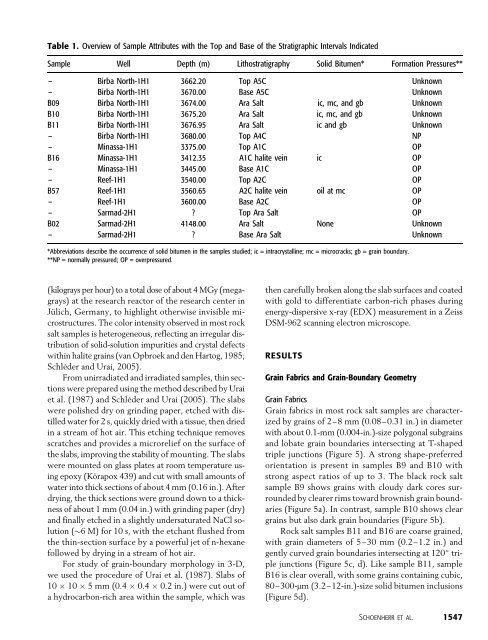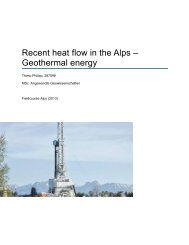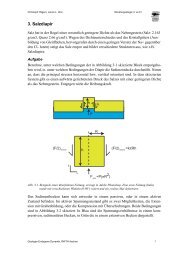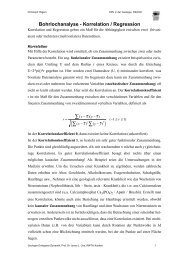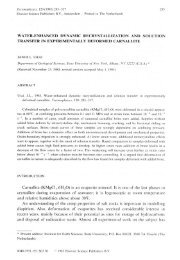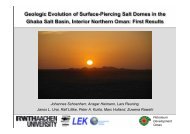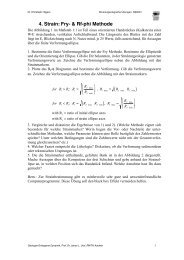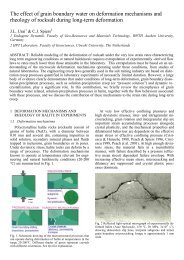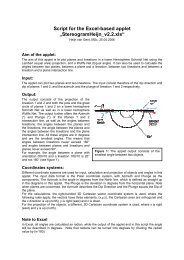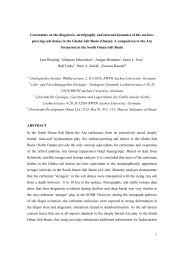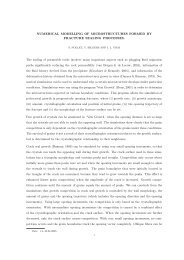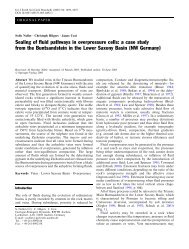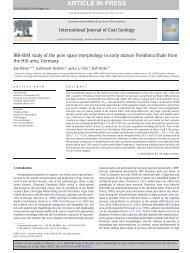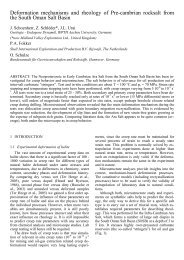Paper - RWTH Aachen University
Paper - RWTH Aachen University
Paper - RWTH Aachen University
You also want an ePaper? Increase the reach of your titles
YUMPU automatically turns print PDFs into web optimized ePapers that Google loves.
Table 1. Overview of Sample Attributes with the Top and Base of the Stratigraphic Intervals Indicated<br />
Sample Well Depth (m) Lithostratigraphy Solid Bitumen* Formation Pressures**<br />
– Birba North-1H1 3662.20 Top A5C Unknown<br />
– Birba North-1H1 3670.00 Base A5C Unknown<br />
B09 Birba North-1H1 3674.00 Ara Salt ic, mc, and gb Unknown<br />
B10 Birba North-1H1 3675.20 Ara Salt ic, mc, and gb Unknown<br />
B11 Birba North-1H1 3676.95 Ara Salt ic and gb Unknown<br />
– Birba North-1H1 3680.00 Top A4C NP<br />
– Minassa-1H1 3375.00 Top A1C OP<br />
B16 Minassa-1H1 3412.35 A1C halite vein ic OP<br />
– Minassa-1H1 3445.00 Base A1C OP<br />
– Reef-1H1 3540.00 Top A2C OP<br />
B57 Reef-1H1 3560.65 A2C halite vein oil at mc OP<br />
– Reef-1H1 3600.00 Base A2C OP<br />
– Sarmad-2H1 ? Top Ara Salt OP<br />
B02 Sarmad-2H1 4148.00 Ara Salt None Unknown<br />
– Sarmad-2H1 ? Base Ara Salt Unknown<br />
*Abbreviations describe the occurrence of solid bitumen in the samples studied; ic = intracrystalline; mc = microcracks; gb = grain boundary.<br />
**NP = normally pressured; OP = overpressured.<br />
(kilograys per hour) to a total dose of about 4 MGy (megagrays)<br />
at the research reactor of the research center in<br />
Jülich, Germany, to highlight otherwise invisible microstructures.<br />
The color intensity observed in most rock<br />
salt samples is heterogeneous, reflecting an irregular distribution<br />
of solid-solution impurities and crystal defects<br />
within halite grains (van Opbroek and den Hartog, 1985;<br />
Schléder and Urai, 2005).<br />
From unirradiated and irradiated samples, thin sections<br />
were prepared using the method described by Urai<br />
et al. (1987) and Schléder and Urai (2005). The slabs<br />
were polished dry on grinding paper, etched with distilled<br />
water for 2 s, quickly dried with a tissue, then dried<br />
in a stream of hot air. This etching technique removes<br />
scratches and provides a microrelief on the surface of<br />
the slabs, improving the stability of mounting. The slabs<br />
were mounted on glass plates at room temperature using<br />
epoxy (Körapox 439) and cut with small amounts of<br />
water into thick sections of about 4 mm (0.16 in.). After<br />
drying, the thick sections were ground down to a thickness<br />
of about 1 mm (0.04 in.) with grinding paper (dry)<br />
and finally etched in a slightly undersaturated NaCl solution<br />
( 6 M) for 10 s, with the etchant flushed from<br />
the thin-section surface by a powerful jet of n-hexane<br />
followed by drying in a stream of hot air.<br />
For study of grain-boundary morphology in 3-D,<br />
we used the procedure of Urai et al. (1987). Slabs of<br />
10 10 5 mm (0.4 0.4 0.2 in.) were cut out of<br />
a hydrocarbon-rich area within the sample, which was<br />
then carefully broken along the slab surfaces and coated<br />
with gold to differentiate carbon-rich phases during<br />
energy-dispersive x-ray (EDX) measurement in a Zeiss<br />
DSM-962 scanning electron microscope.<br />
RESULTS<br />
Grain Fabrics and Grain-Boundary Geometry<br />
Grain Fabrics<br />
Grain fabrics in most rock salt samples are characterized<br />
by grains of 2–8 mm (0.08–0.31 in.) in diameter<br />
with about 0.1-mm (0.004-in.)-size polygonal subgrains<br />
and lobate grain boundaries intersecting at T-shaped<br />
triple junctions (Figure 5). A strong shape-preferred<br />
orientation is present in samples B9 and B10 with<br />
strong aspect ratios of up to 3. The black rock salt<br />
sample B9 shows grains with cloudy dark cores surrounded<br />
by clearer rims toward brownish grain boundaries<br />
(Figure 5a). In contrast, sample B10 shows clear<br />
grains but also dark grain boundaries (Figure 5b).<br />
Rock salt samples B11 and B16 are coarse grained,<br />
with grain diameters of 5–30 mm (0.2–1.2 in.) and<br />
gently curved grain boundaries intersecting at 120j triple<br />
junctions (Figure 5c, d). Like sample B11, sample<br />
B16 is clear overall, with some grains containing cubic,<br />
80–300-mm (3.2–12-in.)-size solid bitumen inclusions<br />
(Figure 5d).<br />
Schoenherr et al. 1547


